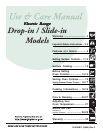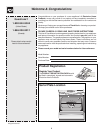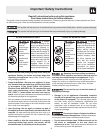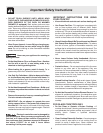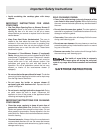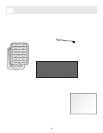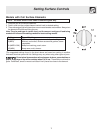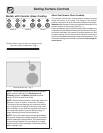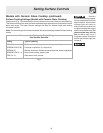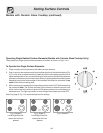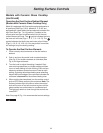
8
Setting Surface Controls
Models with Ceramic Glass Cooktop
Model D shown Only - Fig. 2
About the Ceramic Glass Cooktop
The ceramic cooktop has radiant surface elements located
below the surface of the glass. The design of the ceramic
cooktop outlines the area of the surface element underneath.
Make sure the diameter of the pan matches the diameter of the
element outline on the cooktop (See Fig. 1).
Heat is transferred up through the surface of the cooktop to the
cookware. Only flat-bottom cookware should be used. The type
and size of cookware, the number of surface elements in use
and their settings, are all factors that will affect the amount of
heat that will spread to areas beyond the surface elements. The
areas surrounding the elements may become hot enough to
cause burns.
NOTE: Please read detailed instructions for ceramic
glass cooktop cleaning in the General Care &
Cleaning section and Before You Call checklist
section of this Use and Care Guide.
NOTE: Radiant elements have a limiter that allows the
element to cycle on and off, even at the HI setting.
This helps to prevent damage to the ceramic smooth
top. Cycling at the HI setting is normal and can occur
if the cookware is too small for the radiant element or
if the cookware bottom is not flat (Refer to page 12
under Selecting Surface Cooking Utensils).
NOTE: Due to the high intensity of heat generated by
the surface elements, the glass surface will turn green
when the element will be turned off. This phenomenon
is normal and the glass will come back to its original
white color after it has completely cooled down (White
glass cooktops only).
Cooktop radiant areas that heat. Your appliance may
have one of these configurations - Fig. 1
Model A Model B Model C



